
At the time when Chrétien de Troyes wrote this story (towards the end of the12th Century) armed knights looked like this:
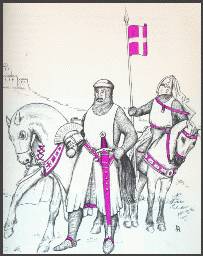
A knight wore a coat of mail called a hauberk made of metal rings linked tightly together to protect his body. Underneath this he wore a padded shirt called an aketon. This gave more protection and made wearing the coat of mail less uncomfortable. He wore a cloth surcoat over these to keep the sun from making his metal mail too hot to bear. The hauberk (coat of mail) and surcoat were split at the front and back so the knight could sit on his horse.
He had a hood of mail (called a coif) covering his neck, head and chin, and a metal helmet with only eye holes, and slits to breathe through. When a knight was wearing one of these helmets, it was very difficult to know who he was. He might be killed by a friend in battle by mistake. So crests on the helmets (sometimes in the shape of animals like lions and bears) or the colours and designs on the gonfalon (the flag on the lance) or the knight's shield had to let others know his name or his family.

Knights wore mail on their arms and covering the backs of their hands like mittens. The palms weren't covered, so the knight could still grip his sword firmly. The legs were protected by mail leggings called chausses, or by mail stockings held up round the waist. A knight wore spurs on his heels to prick his horse and make it move. Spurs were a sign of knighthood, for being on horseback was an important part of being a knight. The French word for knight - chevalier - means horseman (from cheval, horse).
Horses too wore cloth coats (called caparaisons) in their riders' colours and signs on the bridles showing who their riders were.
Besides a sword and a lance (for knocking an enemy knight off his horse or spearing him), knights might carry a mace(left) or a flail(right).


A mace could knock out an enemy even wearing a helmet, while a flail could smash through mail and give terrible wounds.
As time went on, knights began to wear more and more plate armour (made out of sheets of metal) over their mail.
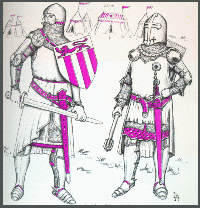
Here you can see the legs and the arms are protected by plate armour.
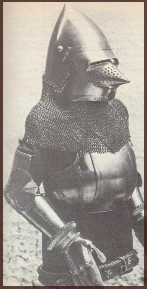
This armour from the 14th Century is partly mail and partly plate armour. Can you see the metal breastplate?

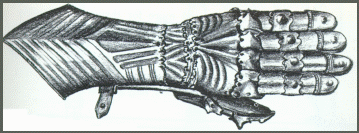
More and more plate armour was used to cover the hands and feet.
By the 15th Century knights looked like this.
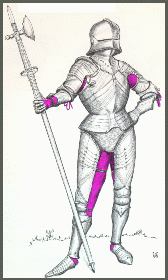
Similar changes took place in horses' armour.
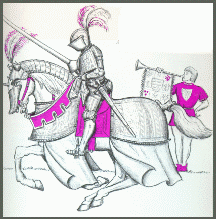
This horse is wearing a nose-guard as well as a helmet, metal plates to protect its neck and a skirt of metal round its body.
You can find out more about the armour knights wore by looking at the tombs of knights in churches.
